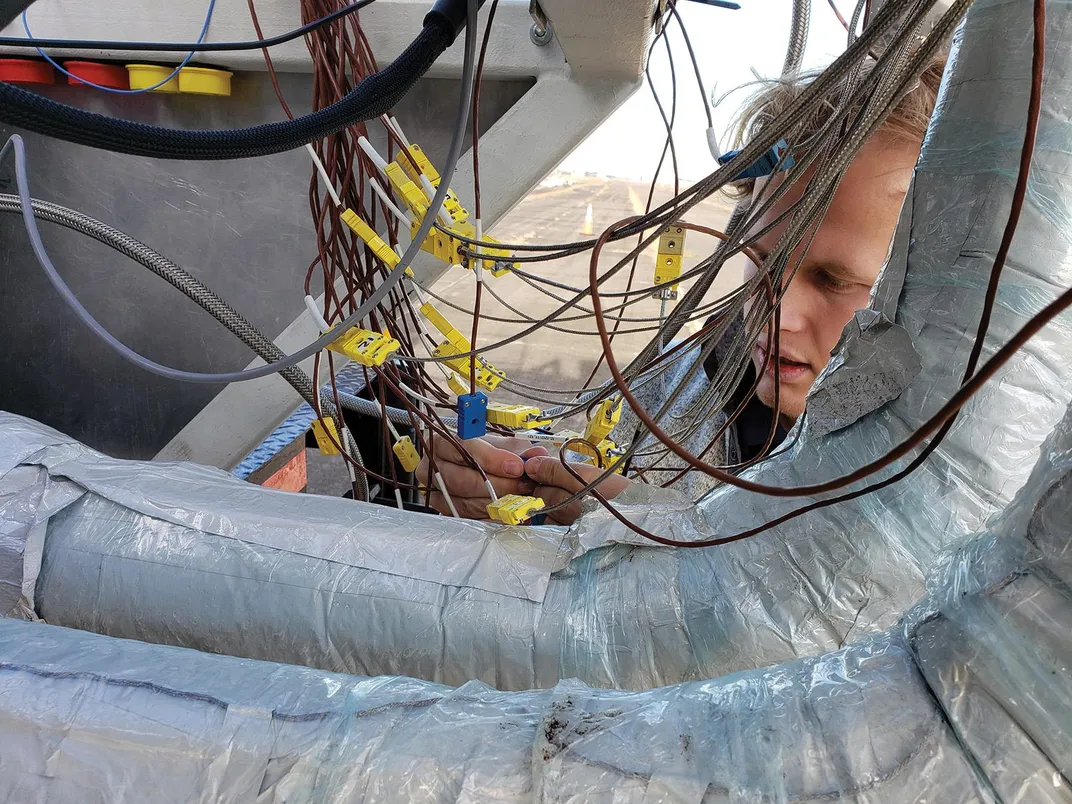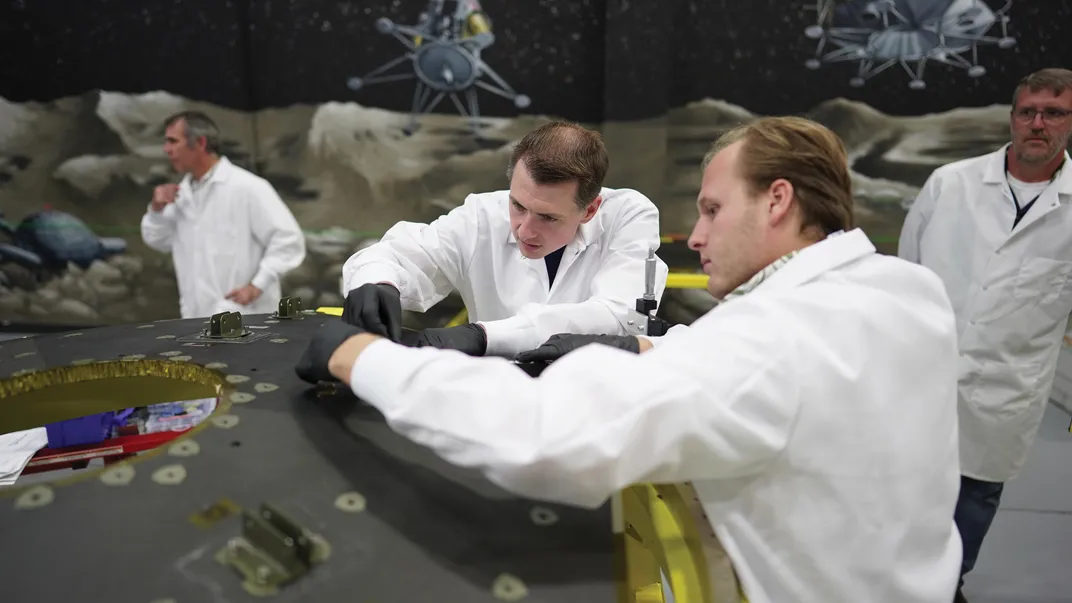The Next Robots on the Moon
In the 1960s, the moon race was war. This time, it’s commerce.
/https://tf-cmsv2-smithsonianmag-media.s3.amazonaws.com/filer/ec/60/ec609d54-72e4-4850-a913-e4918ff56826/12c_dj2022_lunarlandings_novamoonscape3_live.jpg)
Dawn has just broken when a handful of vehicles leave the hangar doors of the Intuitive Machines (IM) production facility, ease their way into traffic, and drive to Ellington Field, an air and space facility outside Houston where the young company tests engines for a spacecraft that will land on the moon.
The centerpiece of the small caravan of pickup trucks and towed trailers is a flatbed with rocket engines mounted on the back—what the IM staff call their Mobile Test Stand. “Instead of building a $500,000 test facility somewhere remote, we bought a $16,000 truck and converted it,” says Intuitive Machines CEO Steve Altemus.
The vehicles pull through the gate, pause at the security checkpoint, and continue to an abandoned taxiway. Large yellow X’s painted on the asphalt indicate that the taxiway is defunct. The staff parks the test stand more than 300 feet from the command trailer and begins the now-familiar process of preparing the rig to fire.
To anyone else on the airfield, the trailer and flatbed look like a pair of random vehicles, but to the staff at Intuitive Machines they are a lunar lander called Nova-C. The main engine’s nozzle juts out the rear of the flatbed, and a vacuum chamber for reaction-control thruster testing sits next to it. Methane, oxygen, and nitrogen tanks stand compartmentalized behind blast walls. The command trailer, another DIY creation, contains the first iteration of the lander’s flight control systems. Never mind how little it may conform to our idea of what a spacecraft looks like: This dissected, road-ready test machine holds some of the hardware (and software) for what will likely be the first American craft to set down softly on the moon since the 1970s.
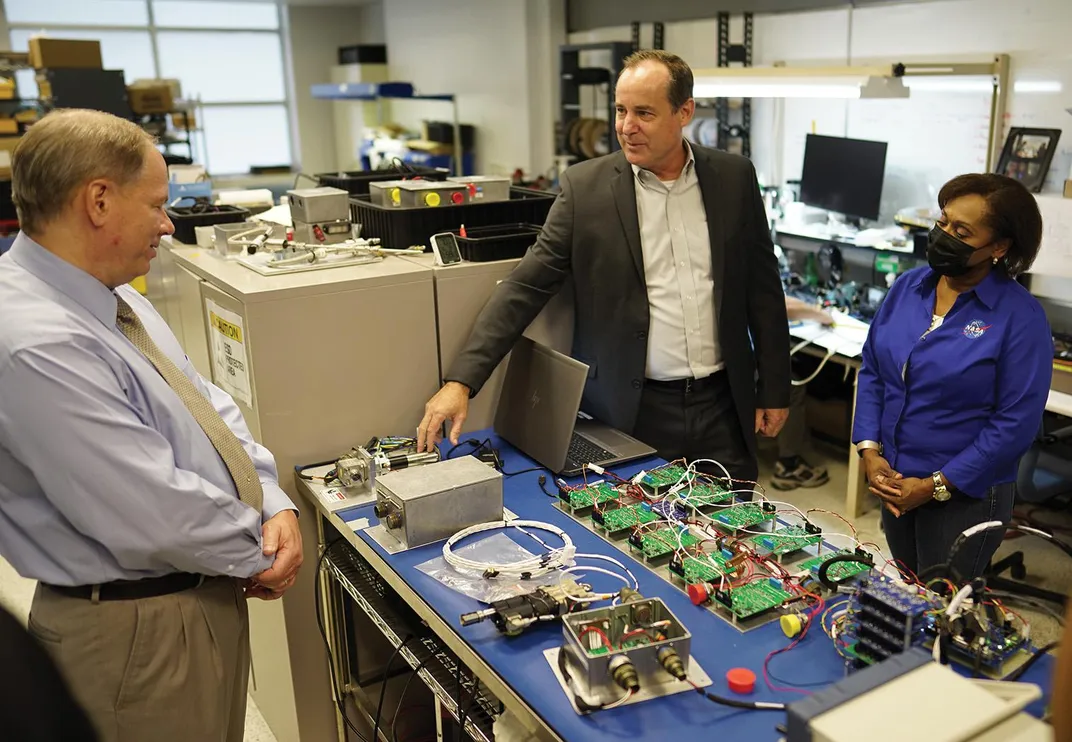
NASA’s plan to return to the moon begins with a fleet of robot landers. The space agency has turned to private industry to realize these ambitions, and there are now more than a dozen companies, large and small, building a new generation of robotic lunar landers.
In May 2019, NASA awarded task orders to three of them: Astrobotic Technology, located in Pittsburgh; Edison, New Jersey-based OrbitBeyond, and Intuitive Machines. (OrbitBeyond cancelled its task order two months later, hobbled by financial issues.) Astrobotic plans to deliver 11 payloads to the moon next year. Its destination is Lacus Mortis, a large crater on the near side. Intuitive Machines will also carry packages to the moon next year. It has six payloads going to Oceanus Procellarum, a lunar “sea” that appears as a dark spot on the moon due to its basalt lava surface. In late 2023, Astrobotic will return with another set of payloads—to the Lunar South Pole. Also in 2023, a third vendor, Firefly Aerospace, will carry experiments to “a non-polar region of the moon,” and a fourth, Masten Space Systems, is contracted to “deliver and operate” eight payloads to the Lunar South Pole.
The plethora of partners reflects NASA’s newly commercial focus. Instead of commissioning spacecraft for companies to build to spec, the space agency is asking industry for mission-ready hardware that can be used by any customer who can pay for the trip. It’s a method that has worked for cargo delivery and, albeit with unwelcome delays, regular astronaut trips to the International Space Station.
“For the sake of NASA, we need to be successful,” says Altemus. “They won’t continue to take those kinds of risks if we fail.”
Adding to the pressure, other companies (including billionaire-backed Blue Origin and SpaceX) are leaping into the fray and promising stiff competition on future lunar task orders. It’s a cutthroat field, and the competitors are litigious. In August, Blue Origin filed suit against NASA alleging “unlawful and improper evaluation of proposals” in the space agency’s selection of SpaceX to build its next lunar lander for astronauts. Meanwhile, China is pressing ahead with a successful rover exploration program, introducing geopolitical gamesmanship and national pride into an already complex landscape.
That puts daily pressure on the IM team to move the project forward, and that leads to long days firing the engines on the abandoned taxiway.
This particular test is happening in January 2020, just eight months after the contract award. (Nine months later, NASA will award IM another contract to deliver a combination drill/mass spectrometer to the moon by the end of 2022.) It takes hours for the IM engineers on the tarmac to ready the test rig for action. They connect power and data lines, set up high resolution video cameras on tripods, endure innumerable dry “click checks” of valves, and finally don protective blue smocks and faceplated helmets to load the cryogenic oxygen.
The pace is as brisk as the January air, but the mood is friendly and collaborative. Everyone chips in on the banal checklist items, like unspooling cables or setting up an awning for shade, regardless of their discipline or rank in the company.
By any metric, this small Houston startup, with around 130 people, is toiling inside an aerospace pressure cooker. So why is everyone here smiling? “We like to do things at a much faster pace than NASA did,” says Greg Vajdos, IM’s project manager for the Nova-C lander and a former Boeing employee.
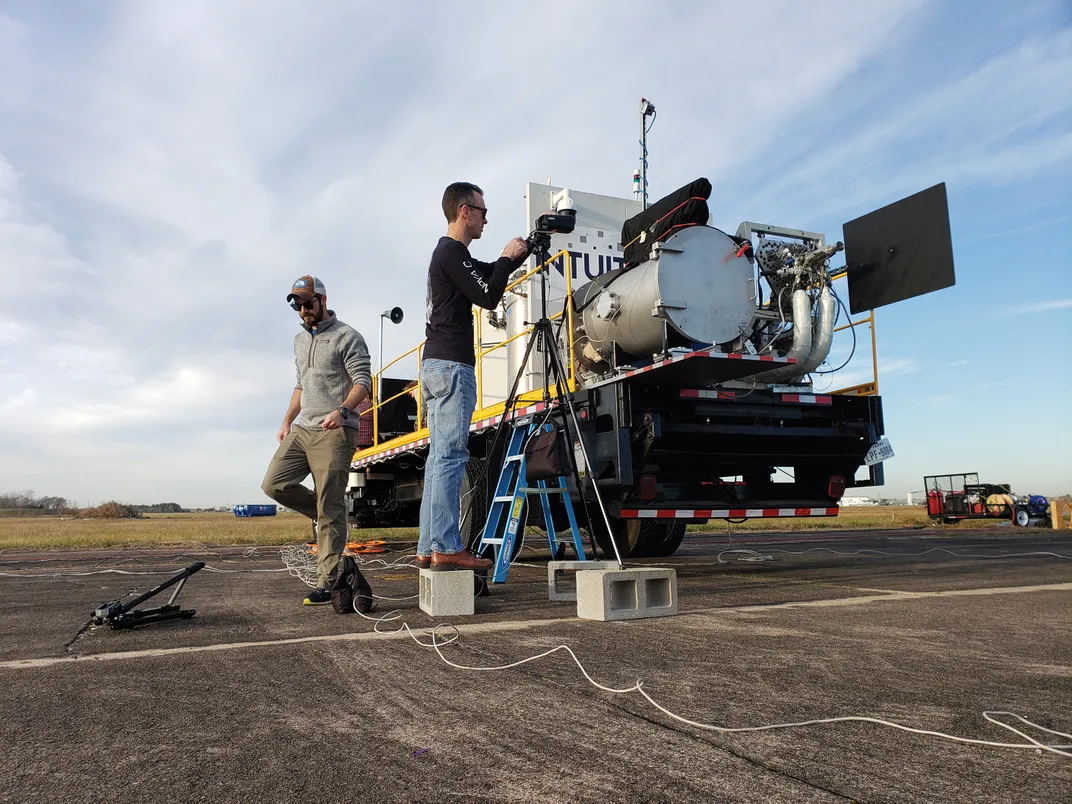
The Other Lunar Cycle
After the Apollo program ended, the moon became a forgotten destination. There may have been a lot of talk about a marketplace forming, and even a high-dollar Google X-prize to reach the surface, but since 1976, only China has landed on the moon.
Today it has become a national imperative for the United States to resume lunar exploration. In March 2018, NASA established the Commercial Lunar Payload Services (CLPS) program, creating a fleet of small robotic landers and rovers to scout the moon as a precursor to crewed missions.
It’s a necessary forebear of the more ambitious Artemis Program, NASA’s plan to establish a long-term human presence on the moon in concert with commercial and international partners, and eventually to use it as a springboard for Mars expeditions. The first step: a lunar lander able to convey 22 pounds of payload to the lunar surface.
When NASA made its lunar intentions clear, Intuitive Machines threw its hat into the ring and pivoted the startup toward a moonshot. The company is a haven, of sorts, for refugees from NASA’s Johnson Space Center, where Altemus served as engineering director. In his time at NASA, the agency launched dozens of shuttle flights, from the return to flight after Challenger to the shuttle’s retirement. But life at NASA soured for him. “We were trying to create a sense of urgency,” says Altemus. “We had the retirement of the space shuttle, we had assembly of ISS completed. Then we had the cancellation of the Constellation Program, and it all became about building capability with no destination. We said, based on that, let’s jump.”
Intuitive Machines started as a hybrid commercial company/think thank that investigated engineering solutions for the aerospace, energy, and health care industries. The venture is backed by entrepreneur Kam Ghaffarian, co-founder of Stinger Ghaffarian Technologies, NASA’s second largest engineering services provider.
But until 2018, flying drones over fires, not landers on the moon, was at the top of the IM agenda. That’s when a shift in U.S. policy regarding the moon created a renewed lunar “mission focus and the sense of urgency,” Altemus says. The small firm bested others for the first CLPS launch, and the race was on. Staff doubled and Intuitive Machines now has a mix of NASA veterans and fresh-out-of-school engineers.
Mario Maggio wanted to come to Houston, still a beacon for human spaceflight, after he received his master’s in aerospace engineering (focus on bioastronautics) at University of Colorado Boulder. Now the 25-year-old is part of a team working on a lunar lander for NASA. “Not too many people who are not retiring will have experience landing on the moon,” he says.
University partners on the Nova-C project include Utah State, the University of Colorado, Embry-Riddle Aeronautical University, and Texas A&M. There’s also a local community college with an office in the IM Houston facility, a pipeline that turns students into high-tech workshop employees.
The young company has another legacy from its NASA roots: Texas regional pride. “It’s our birthright as a city,” Altemus says. “If Houston can’t field the team to land on the moon, what city can?”
His optimism has survived disappointment. Intuitive Machines partnered with Boeing on a human-rated NASA lander, but Boeing lost the Human Landing Systems (HLS) bidding war among entrants from Blue Origin, SpaceX, and Dynetics. Still, having developed hardware for the Artemis program, the staff at IM believe there’s room for them at the table. For example, their 3D-printed, VR3500 lander engine holds the record for continuous test duration at Marshall Space Flight Center’s Test Stand 115. It may yet become a part of another outfit’s lander. “We expect to be teamed with one of the HLS-contract-winning companies,” say Josh Marshall, an IM spokesperson.
Like the rest of the industry, IM is being buoyed by a historic confluence of government funding and commercial potential—none of which means much if IM doesn’t stick its landing.
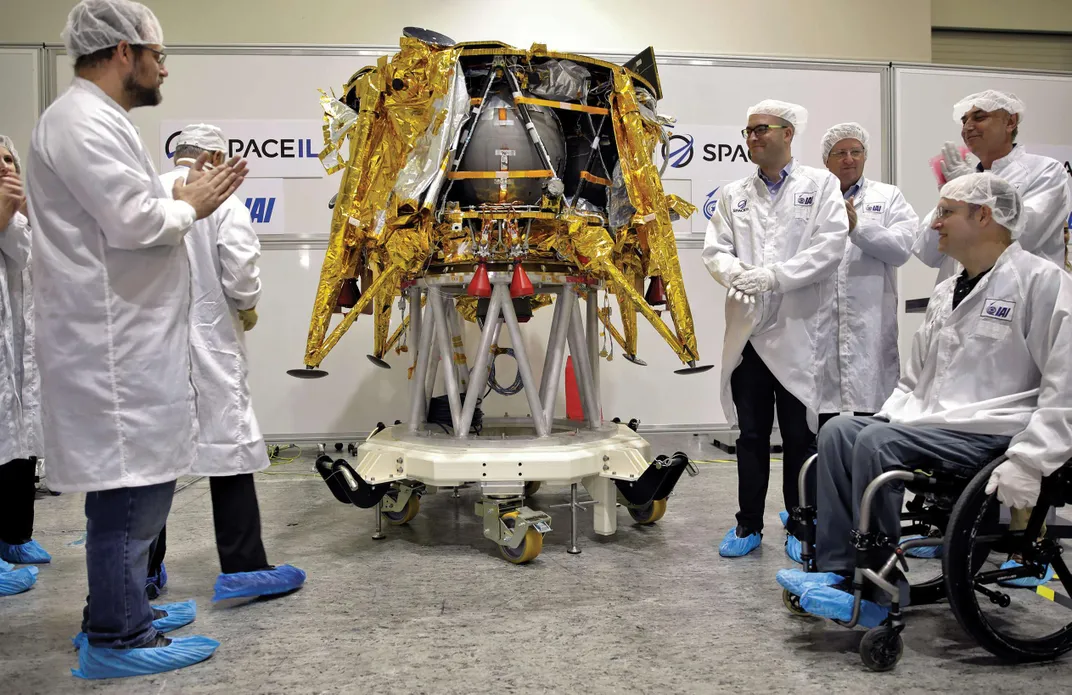
Heartbreak on Regolith
The aeronautical world received a dramatic reminder of how hard it is to land on the moon in April 2019, when a private Israeli organization, SpaceIL, closed in on the final minutes of its lunar journey. The Beresheet lander traveled 3.4 million miles, with just 10 more to go.
The spacecraft started for the surface, using an automated system to fire the main thruster and slow the craft. “The orbital velocity was about 1.7 kilometers per second and needed to be reduced to zero in order to reach the surface softly,” recalls Yoav Landsman, the senior systems engineer at SpaceIL during the landing.
“The physics of orbits is that if you reduce your velocity, you lose altitude,” he says. “You literally start falling toward the ground at an increasing vertical speed.” When it comes to the moon, gravity is the real enemy. “The lack of atmosphere is not the main criterion,” Landsman says. “Landing on small asteroids with no atmospheres is more like docking to a space station than landing, since they have a very weak gravity. The moon, on the other hand, is very different because it’s massive and pulls hard.”
The SpaceIL team uploaded commands to the spacecraft to rotate so the main engine pointed against the direction of the orbital velocity, and then fired the engine. The orbital velocity began to drop, taking almost 15 minutes to zero out. Another pending rotation would bring the spacecraft into its landing orientation, to drop straight down and using the main engine to slow to a near halt.
A telemetry indicator blinked red at 19:22; the lander was plummeting at nearly 75 meters per second. Then the light went dark: malfunction.
The SpaceIL team scrambled to restart the system. In such a scenario, “there is a very slim chance of intervention, because of the communication lag due to the long distance,” Landsman says. “You would need to get an indication of the failure, reach a decision, and send a response. If the failure results in an engine cut-off, then you cannot start it in time by command from Earth.”
The engine did restart, but too late. Beresheet’s vertical speed was 134 meters per second, and its horizontal speed 947 meters per second. At just a mile away from the surface, the lander was doomed. The loss of signal, like a coffin closing, occurred at 19:23.
Landsman says it’s a lesson in deep space engineering. “It means that the autonomous process should be very robust and resilient, with a proper onboard redundancy and backup management,” he says. There may be another lesson he learned; his skill set could be useful within an emerging lunar landing industry.
“Since there aren’t many people in the world who have sent spacecraft to the surface of the moon, I feel that I have a huge responsibility to help human-kind make the next giant leap,” he says. “I am currently on the first step of starting my own commercial company to make lunar landings more affordable and accessible.”
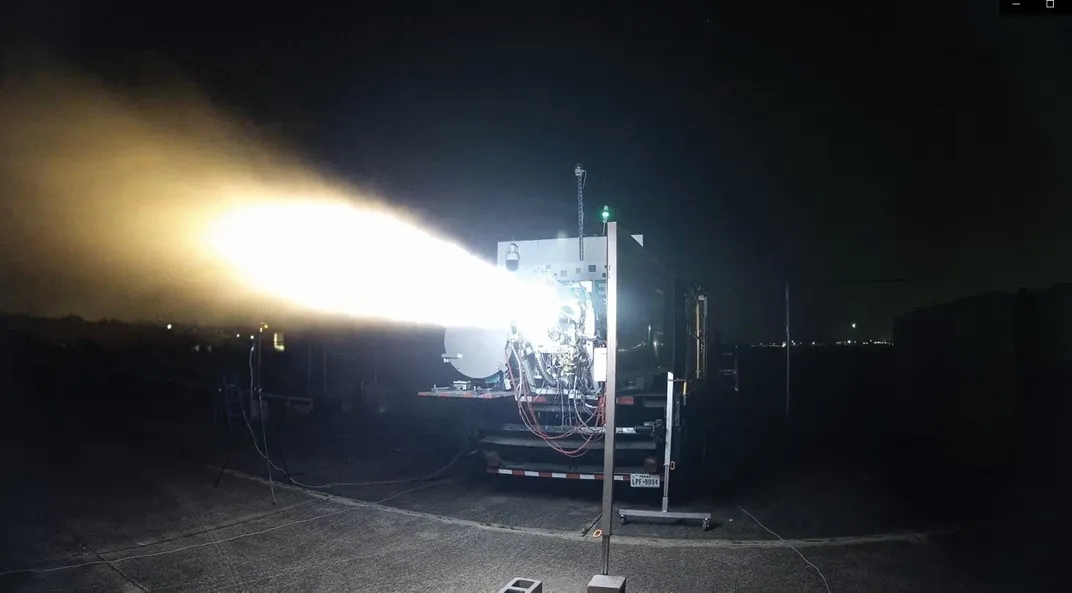
Build, Fly, and Evolve
Rob Morehead, IM’s in-space propulsion principal and designer of both main and reaction control system (RCS) engines, sits inside the command trailer and gazes intently at the schematic diagrams on the wide computer screens mounted on the interior trailer wall. Today’s tests are focused on a new dual-ignition system.
These are deep-space engines, made to operate autonomously, guided by commands previously uploaded from Earth. The flight-control computer is the ultimate operator of the engine. A gout of greenish-blue flame spears from the thruster’s 0.38-inch nozzle, knocking a flock of tiny ice particles from the LOX (liquid oxygen) lines into the vacuum chamber. The chamber is open. These are just ignition tests and as such don’t need to replicate a space environment.
That green color in the flame means some metal has burned; the methane/LOX flames are typically a clear blue hue. The next test burns more clearly, and the next creates a darker blue color. The tests are almost indistinguishable, but in each Morehead and his team have made adjustments, seeking the secret recipe of pressure, temperature, and fuel-oxidizer mixture that will set the lander down safely. The speed and strength of the thruster at ignition is vital for RCS engines, which must respond immediately for precise control of the spacecraft.
The use of methane is novel. When Nova-C launches, it will be the first lunar spacecraft to use an engine powered by the reaction of liquid oxygen and liquid methane. Current vehicles use “hypergolic” fuels like monomethyl hydrazine, which packs a good punch by igniting instantly when combined with nitrogen tetroxide but is also toxic. Though it wasn’t Morehead’s main reason for settling on methane, one advantage is that it could be manufactured on Mars using components of the atmosphere and subsurface ice.
Engines of this type “have never been flown in space, so this is our chance to prove it’s not a risk,” says Morehead. The Nova-C’s main engine will slow the craft, while the RCS engines govern its orientation. Both need to work precisely to translate the automated system’s commands into immediate action during the landing.
“When we go to land on the moon, we want to aim for a field that has a 99 percent chance of landing successfully, in a 300-meter circle,” says Altemus. “Then with our landing site initially identified, we screen the area for boulders and rocks that might jeopardize our safe landing.”
The other 2022 CLPS lander, Astrobotic’s Peregrine, uses a visual system to navigate, but also bounces laser pulses off the surface during its descent to gauge its speed and avoid hazards. The company developed that system under NASA contracts going back to 2014, and tested it in Mojave, California on landers built by the small firm Masten Space Systems. (See “Land Right Here!” Feb./Mar. 2020.)
Because Nova-C uses only visual image processing to land, there are limitations. The same way an optical bombsight doesn’t work over water for a lack of landmarks, the dark lunar surface gives the spacecraft no clues on its specific location. “There’s certain lighting conditions that we have to have to land on the moon,” Altemus says. “We’ve relaxed the requirement to land anywhere, any time on the moon. Those are requirements that get you in trouble.”
Staff with NASA experience gesture in the general direction of the Johnson Center, where “good enough” equated to “unacceptable.” Here, it’s different, holding to the “new space” ethos of “build, fly, and evolve along the way.”
“When I was at NASA, we wrote every single requirement down that we could imagine, before the first procurement went out to any of the vendors, so they could bid it as close as they could,” Altemus says. “Why did we write ourselves into those requirements, and then make it so hard to change them, and give the contractor no flexibility? Here, we’re able to build a lander that isn’t perfect, but can land on the moon. After we’ve landed on the moon, [we] refine it, over and over and over.”
Intuitive Machines plans to fly to the moon with the Nova-C even as they develop the Nova-D, which will have the capacity to carry 1,100 pounds to the lunar surface.
For engineers and executives accustomed to watching this technology develop at a glacial pace, the rapid evolution of both the product and the market is thrilling to witness. “This is the most fun I’ve had in my career,” Altemus says.
While the veterans enjoy the freedom of the commercial shift, the younger staff expect the future to get only brighter. Many of them say they’re the generation that will oversee the exploration and utilization of the solar system.
“The moon is an access point to farther destinations,” says William Amtmann, a 22-year-old mechanical engineer whose role testing IM’s engines is his first full-time job in aerospace. “This is opening up a whole new field.”
Lunar Lander Pole Positions
Securing a niche in the lunar marketplace means staying ahead of the rest of the emerging competitors, many of which also hold NASA contracts. The original nine companies with Commercial Lunar Payload Services (CLPS) contracts, which makes them eligible to bid on future NASA task orders, were joined in 2020 by five more.
Everyone involved is hoping that there will be enough variety of payload sizes coming from NASA to give many of them a chance to fly. Astrobotic’s shot will come when it carries up NASA’s Volatiles Investigating Polar Exploration Rover (VIPER) to the lunar South Pole for a 100-day mission in late 2023 seeking water ice.
The $199.5 million task order represents a major win for one of the original CLPS competitors. Astrobotic has been in business for 14 years, compared to IM’s commercial birth in 2018. The Peregrine lander is on track to hitch a ride with other payloads on the Vulcan Centaur launch system, United Launch Alliance’s replacement for Atlas and Delta rockets, in 2022. But delays with the Blue Origin-supplied BE-4 engines might cause the selection of a new launch provider, as happened with the Europa Clipper mission.
Another mission, IM-2, is slated to send the first lander to the moon’s South Pole in December 2022. IM’s Nova-C will carry the Polar Resourced Ice Mining Experiment-1, the first-ever lunar ice drill, and a rover to demonstrate that 4G communications can work on the moon. IM scored another win with partner Arizona State University in July 2021 by securing a $41.6 million Tipping Point contract from NASA to operate a “hopper-lander” on the moon during IM-2. Deploying from the Nova-C, this Micro-Nova will examine deep lunar craters. Data from the rover’s optical imagers will be a boon to any future lunar ice miner.
If private companies, universities, and research organizations can pool their resources, the moon is now in reach. This may help IM’s former NASA staffers avoid a repeat of their fate at the space agency, where shifting funding priorities idled them. The ultimate hedge against such reversals of fortune is to fly private lunar missions. IM is doing just that. In August, it announced it would be renting space on its second NASA-sponsored moonshot, IM-2. Four customers will piggyback on IM-2’s Falcon 9 rocket.
What’s perhaps even more commercially ambitious is IM’s bid to dominate the private sector in lunar communications. IM-2’s Nova-C will launch a York Space Systems satellite into lunar orbit—to provide bandwidth for use by educational and private sector customers.
Which can’t happen until the liquid-oxygen/liquid-methane engines are perfected.
That’s what IM is working on on this day back in January 2020 at Ellington Field. It’s a long day. Homemade sandwiches are extracted from bags. The only bathroom is a bucket with a plastic seat. The main engine never ignites. The staff swarm the vehicle, replacing valves and purging the lines.
It appears the oxygen supply has too much moisture and ice is clogging the valves. The hunt for a new supplier, an unwelcome but small setback, will begin the next day.
The RCS tests fare much better, igniting dozens of times. Each brief burst provides data about the engine’s performance and feeds into the software team’s landing simulations. The air temperature drops even before the sun sets. A busy and frustrating day has come to an end, but the chore of packing up the gear lies ahead. Cables are respooled and stowed, umbilicals disconnected, the tent broken down in the now whipping wind.
That’s the downside of mobile test stand operations, of which there will be dozens more. In October 2021, reached by phone while filling up gas cans for the 57th hot-fire test in two-and-a-half years, program manager Vajdos says IM is building a “flame range.” It’s a bunker, essentially, that will allow engine test firings on mobile test stands within its walls, without schlepping out to the disused taxiway that was the site of last January’s test.
As that January 2020 test draws to a close, the moon clears the horizon and blur of the Earth’s atmosphere, and is now gleaming, nearly full, in the early evening sky. The staff’s eyes tend to flicker up at it as they work. If they need any motivation, it’s beckoning overhead.
